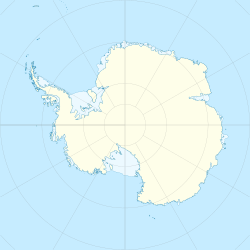Mügge Island facts for kids
|
Location in Antarctica
|
|
| Geography | |
|---|---|
| Location | Antarctica |
| Coordinates | 66°55′S 67°45′W / 66.917°S 67.750°W |
| Administration | |
| Administered under the Antarctic Treaty System | |
| Demographics | |
| Population | Uninhabited |
Mügge Island is a small island located near the icy continent of Antarctica. It is part of a group called the Bennett Islands. This island is special because it is completely uninhabited, meaning no people live there.
Contents
Where is Mügge Island?
Mügge Island is found in a place called Hanusse Bay. It lies about 1.5 nautical miles (which is about 2.8 kilometers) north of the western end of Weertman Island. This area is part of the Graham Land region of Antarctica.
How Was Mügge Island Discovered?
Scientists and explorers first mapped Mügge Island using photos taken from airplanes. These photos were captured during two important expeditions:
- The Ronne Antarctic Research Expedition (RARE) in 1947–48.
- The Falkland Islands and Dependencies Aerial Survey Expedition (FIDASE) in 1956–57.
These aerial surveys helped cartographers (mapmakers) create detailed maps of this remote part of the world.
Who Was Mügge Island Named After?
The United Kingdom Antarctic Place-Names Committee (UK-APC) officially named Mügge Island. They chose to honor a German scientist named Johannes O.C. Mügge. He lived from 1858 to 1932.
Otto Mügge's Work
Johannes O.C. Mügge was a mineralogist. This means he studied minerals and rocks. In 1895, he did important early research on how ice can change shape under pressure. This is known as the "plasticity of ice." His work helped us understand how glaciers and ice sheets move and flow.
Life on Mügge Island
Because Mügge Island is in Antarctica, it has a very cold and harsh environment. It is covered in ice and snow for most of the year. No permanent human settlements exist on the island.
Antarctic Treaty System
Mügge Island, like other parts of Antarctica, is governed by the Antarctic Treaty System. This international agreement makes sure that Antarctica is used only for peaceful purposes, like scientific research. It also protects the continent's unique environment.


